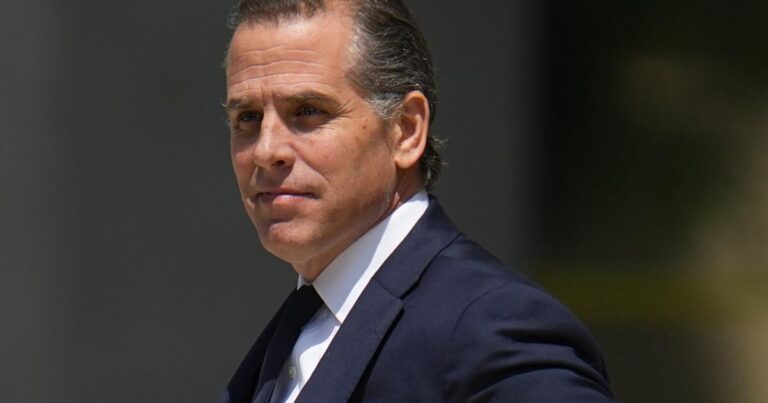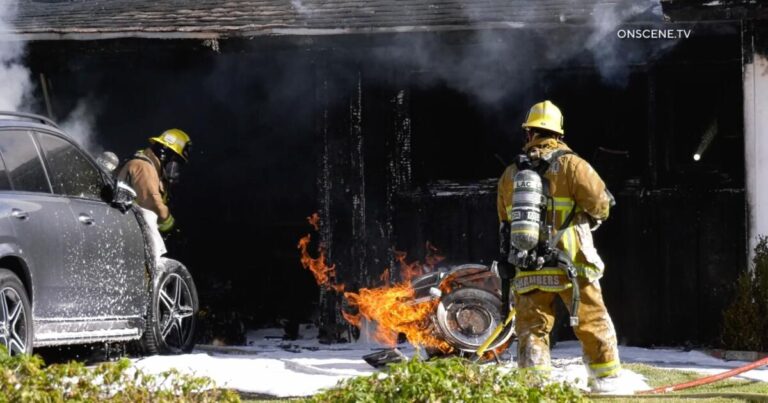The soft-spoken 18-year-old had run out of food for his three younger siblings.
He told the Canoga Park High School counselor that his mother was disappearing for days at a time, leaving him and his siblings, ages 11, 3 and 1, with hardly anything to eat. He filled his stomach with water to stave off the hunger.
The senior, Alvondo Williams Jr., was sent home May 6 with a cooler filled with bread, milk, sandwich meat and cereal. The counselor then called the Los Angeles County Department of Children and Family Services hotline to report possible neglect in a home with “more condiments than food.”
Over the next two days, an LAPD officer and then a DCFS social worker toured the family’s Canoga Park apartment. Both took the full refrigerator — stocked with food the school had just provided — as a sign the children had enough to eat, according to DCFS records obtained by The Times.
Despite receiving several reports this spring about a family with an absent mother and gnawing hunger, the DCFS never opened a case — even after another school counselor called the hotline on May 13 to say that Williams’ mother had kicked him out of the house.
The 11-year-old, James, was now caring for the toddler, Penelope, and the 1-year-old, Thyri, the counselor said.
On July 1, Thyri was found dead, “malnourished” with “sunken eyes,” a detective told the DCFS. She showed signs of dehydration, “poor diet” and possible neglect, according to the county coroner’s postmortem examination.
James had resorted to feeding his baby sister jelly and french fries, according to a DCFS report.
A DCFS analysis had determined that the situation was “high” risk, which typically means that social workers should open a case. But, according to DCFS records, the social worker overrode the recommendation — a decision that requires a supervisor’s approval.
DCFS social workers are supposed to refer a child to a medical professional if they believe the child is malnourished. But the social worker described Thyri as “happy” and closed the referral before a doctor saw her.
“If there’s a lack of food in the home, and there’s a 1-year-old, that’s extremely dangerous,” said former DCFS director Bobby Cagle, who resigned in 2021. “You can’t just take the word of a parent.”
The DCFS said in a statement that it is legally barred from discussing details of a case but that “safety is at the heart of our work.”
“Daily, DCFS social workers make difficult judgement calls — leaning on child welfare best practices, experience, training and education — as to how they can best help families while parents resolve complex personal issues,” the agency said.
In January, Williams’ mother quit her job at 7-Eleven and started leaving for days at a time. He didn’t know where she went.
“She would always say that she’s grown and she can go where she wants to,” said Williams, who now lives on his grandfather’s farm in North Carolina and spoke by phone with The Times.
His mother, 37-year-old Jennifer Wood, declined to comment, saying her daughter’s death was a private matter.
Williams said he stopped going to school in February after his mother refused to give him quarters for the laundromat and he didn’t want to show up in dirty clothes. He spent his days at home watching gaming YouTubers and listening to dubstep.
When his mother honked her car horn, it was the signal for the children to come pick up food — often, containers of potato salad or mac and cheese — from the driveway before she drove off again. The food would typically last a day, but she’d be gone for two or three, he said.
The longest his mother left, Williams said, was for a week when she went to Las Vegas.
On April 23, the day after Wood got back from Vegas, James called 911 after an explosive fight with her, bringing the children onto the radar of DCFS for the first time this year. The agency had received reports from the LAPD in 2022 and 2023 about fights between the mother and her then-partner, as well as with James, but never opened a case, according to DCFS records.

The Canoga Park apartment where Alvondo Williams Jr. lived with his three younger siblings. His mother would honk when the children were supposed to come pick up food from the driveway, Williams said.
(Myung J. Chun/Los Angeles Times)
James told an LAPD officer that his mother had been in Vegas with her new boyfriend and that there was “very little food in the home,” according to a report the police made to DCFS.
When a social worker showed up later that day, Wood said she had been gone only a few days for work. James grabbed his backpack and stormed out, accusing her of lying, according to the social worker’s report.
One day, Williams weighed himself on the scale in his mother’s bathroom and realized he had lost 20 pounds.
At a breaking point, he called his grandmother in North Carolina.
“He told me how they had been living. I said, ‘You go back to school and tell them what happened,’” said Oneida Williams, 85. “‘They can send somebody to you.’”
On May 6, as Williams was unpacking the cooler of food he received from school, a police officer arrived.
The school counselor had told the child protection hotline that Williams, disheveled with a ring of dirt around his neck, had “not stopped eating” since he arrived and “has asked for food the entire time he has been there,” according to a summary of the call.
But the children did not “appear malnourished or unhappy,” the LAPD officer reported to DCFS.

Williams, 18, at his grandmother’s home in Norlina, N.C. He moved there in September, after he said his mother kicked him out of their Canoga Park home.
(Melissa Sue Gerrits / For the Times)
Williams was holding “a bag of food,” and there was canned food and peanut butter in the cupboard, the officer reported. Williams said he planned to feed his sisters sandwiches and fruit that night, according to a DCFS report about the incident.
The officer’s visit coincided with one of their mother’s visits — she arrived with mac and cheese, chips and chicken.
She “quickly dropped off the food and left,” the officer told DCFS. He said he didn’t speak with her.
The next day, Williams had just returned with more food from his school when a social worker stopped by.
“They showed up literally five minutes after I got back from the school,” Williams said. “When they came, it looked like we had food.”
The social worker noted that the refrigerator and freezer were “stocked” with “plenty of food,” according to his write-up of the visit.
That day, the social worker met with the mother, who said that Williams was “being ridiculous” and she had had enough of his “bad attitude.”
That night, Wood kicked Williams out of the apartment.
“You need to pack your s— and leave,” he recalled her screaming at him.
A week later, the second call from Canoga Park High School came into the child protection hotline. Williams was living at a homeless shelter, the counselor said, and James was now in charge of the two youngest children.
The counselor said they “cannot imagine what the siblings look like.”
James was a computer whiz in online school who had been diagnosed with autism and a behavioral disorder. He often ran away from home, according to a DCFS report.

Twice, counselors at Canoga Park High School called the DCFS child protection hotline about Williams and his younger siblings. DCFS never opened a case.
(Myung J. Chun/Los Angeles Times)
Williams said he knew an 11-year-old was ill-suited to look after a toddler and an infant. But his mother had kicked him out, and he was exhausted.
“I didn’t want to leave them, and I knew it was wrong,” Williams said. “But I really couldn’t do much.”
Williams stayed at a homeless shelter through September, finishing high school before heading to North Carolina, where he had spent much of his childhood. He said nobody from the DCFS contacted him again.
No social worker visited the apartment following the call from the school warning that the 11-year-old was in charge, according to the DCFS investigation into the hotline calls. A social worker’s attempt to speak with Canoga Park High School was “unsuccessful.”
Nor did the social worker vet Wood’s claim that her roommate and a family friend helped with the kids when she was gone.
The roommate, a security guard in his thirties, told a social worker after Thyri died that he usually got home at 8 p.m., left at 4 a.m. and didn’t help with the children.
On May 22, the social worker wrapped up his investigation, deeming the allegation of neglect “inconclusive” and closing the referral.
“The mother practices appropriate parenting skills, as well as providing adequate food, clothing, medical care and supervision for the children,” the social worker wrote in his final report.
On Saturday, June 29, James fed his baby sister french fries, he later told a DCFS social worker.
He gave her the “last bottle of milk” and some jelly “because that was what he knew they had that she would be able to eat,” James said, according to a DCFS report.
By then, Thyri, paler than usual, couldn’t crawl or stand up on her own, James said. Her stomach looked strange and “sucked in.” He noticed a bumpy “black spot” on her head.
On Sunday, she had nothing. They were out of milk, and his mother had warned him against giving water to babies.
On Monday morning, he texted his mother for money to buy milk — the third time he had asked since she left the house Saturday night. She sent the money that afternoon.
As he was leaving for the store, he said, he went to check on Thyri. He found her in her crib with her head back and eyes open, according to a DCFS report. Her arm was stiff.
Thyri had been dead for 18 hours when police were called to the apartment, a coroner’s official told an LAPD detective. She had a bruise on her forehead and severe diaper rash with sores.
Inside, LAPD officers found overflowing trash cans and piles of unwashed clothes and dirty diapers, according to a DCFS report. The floor was covered in cat feces, and the crib was saturated with urine. The refrigerator was empty.

Williams said he still doesn’t know exactly how his baby sister died. The autopsy is inconclusive and the LAPD investigation is ongoing.
(Melissa Sue Gerrits / For the Times)
The LAPD arrested Wood on July 11 on suspicion of child neglect. She was released four days later and has not been charged with a crime.
Prosecutors are awaiting more information from the coroner’s office on how Thyri died, according to a source familiar with the investigation who was not authorized to discuss the case publicly. The autopsy did not determine a cause of death.
L.A. County Supervisor Lindsey Horvath, whose district includes Canoga Park, called Thyri’s death “an absolute tragedy.”
“I am heartbroken and I am sick because Thyri and her siblings deserved better. Every child deserves basic care and decency — food, child care, and support,” she said in a statement. “We are responsible for doing better for all children in LA County.”
After Thryi’s death, the DCFS removed James and Penelope from their mother’s custody.
James is in foster care, and Penelope lives with her father’s cousin in Lancaster. Her father, who lives in Arizona and asked not to be named, said he is still trying to “piece together” how his daughter spent the months before her sister died.
The DCFS told him there “was a travesty” and a “bunch of neglect,” offering few other details, he said.
Penelope has trouble sleeping and isn’t potty-trained, he said. She seems comfortable in dirty diapers.
“That’s how she was raised. It’s awful,” he said. “Who the hell knows what was going on in that house?”




















